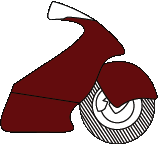
Mon-Fri: 9am-6pm
Sat:
9-12
Store Hours:
|
|||||||||||||||||||||
|
Value Versus Price
Price is the immediate cost of the object. This is a simple number and the basis of most peoples’ decisions on buying. Walmart’s “The low price Always” conditions a person to accept the fact that low price is good. Evidently they became aware of what they were worth. Low price simply indicates the lowest cost of producing goods and/or services. This cost is based on the materials and labor involved in its production. There is also profit built in to all of it. Profit is not a dirty word, but is a necessity of doing business whether in China or here in the USA. Having some amount of profit allows a store to continue operating and pay a living wage to their employees so that they are encouraged to stay in this field. Forgoing profit in the short term to achieve long-term goals is what the big box stores do (along with China). They can beat down the prices by economy of scale and reductions in cost. China achieves this by reducing labor costs and material costs. One might consider the ability to pay someone $1.60 per hour to manufacture an item adequate advantage, but an additional savings is seen by reducing the quality of the basic materials because it is.... (are you ready?)... cheaper. It is not xenophobic to avoid some overseas manufacturers that have continual trouble with consistency in their products. Our biggest struggles with quality issues in the last 36 years of doing business here have repeatedly been with many brands of Chinese-produced goods. These are CHEAP items. Always the lowest initial cost. Value is the ratio of cost versus durability. If the item cost twice as much but lasts three times as long, the math is a no-brainer. If the likelihood of failure at a critical moment is an issue, once again, the math is a no-brainer. If the failure of a cheap part leads to downstream issues (e.g. an oil filter coming apart and ruining a motor, a ball bearing failure causing a wheel to wobble you into the weeds, etc.) once again, small issues can quickly compound into large expensive issues – far more expensive than the original difference in price that led to a cheap part. America has been brainwashed into thinking that price is everything when it isn’t. Putting in cheaper electronics (circuit boards and related components) leads to expensive failures in critical instances. Yes, there may be a warranty, but that is a cold comfort if a faulty part is in a machine that is monitoring your life, flying the plane you are in, or part of a vehicle you are driving. We at Motorcycle Performance strive to provide value. One thing I have learned over quite a few years and through a number of different projects is that the sacrifice of quality and a project’s success is pretty poor payoff for saving a few bucks. When was the last time you were truly looking at the quality of an item rather than the price? How many cheap things failed and pissed you off? You could find the money to do it again, so it might be more efficient to do it right the first time? This isn’t like deciding what peanut butter to buy... Motorcycles deserve the best. Not necessarily extravagant but above the minimum threshold for the bare minimum. Motorcycles are a high demand platform in both their operation and maintenance. Just looking for the cheapest doesn’t do you or the motorcycle justice. That is why I have the people I do. I haven’t ever looked for the cheapest technician, EVER! The confidence and enjoyment from a quality job is something a person needs to feel to appreciate. I try to test ride as many of the bikes we work on as I can and it sure is nice. As an example, I decided I wanted to run a Ducati as a nitromethane-burning platform a few years ago. When facing this purchase, the component costs for the fuel injection, pump and calibration the costs were daunting (over $4200 by the time it was all said and done). I did look at alternatives based on cost (that is a lot of money for anyone) but ultimately decided that Kinsler Fuel Injection was worth the cost because it would assure me of the quality I was looking for versus the cost of blown motors, burned pistons and wasted runs. The first run down the track was successful and the next 80 runs, including burning 18 gallons of nitro at Bonneville and the quickest passes by a Ducati in America convinced me it was money well spent. When an issue arose with the fuel pump due to an o-ring compatibility issue the problem was dealt with succinctly and well. I even received a call from John Kinsler himself. I could have done the system cheaper, but the value far exceeded the cost difference. So keep this in mind when the decision arises as to whether to try and save that extra $8 or $10 on the next tire. Is it really worth the messing around and is your best interest served at the expense of the local service store who relies on at least a modest profit to be around to answer your questions about the recommended pressures, wear patterns alternative tire choices, handling characteristics, etc., etc. That is the value part of the equation that brings the math into focus. Remember, you are a motorcyclist because you love it! Applying the value versus price thought process is a bit more work, but can be applied to virtually everything you are involved with. Do you buy the very cheapest produce? That can usually be found in the bin around the back of the store. Thank you, Updated 5/21/14
|
|||||||||||||||||||||
A Division of Performance Industries, Inc. |
